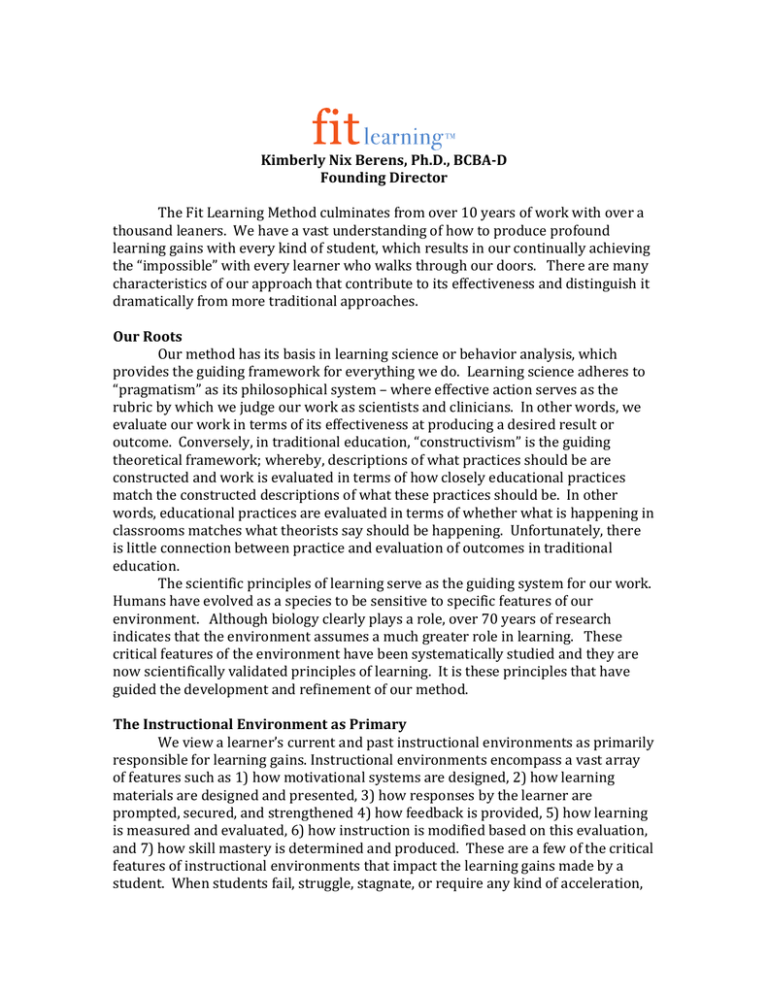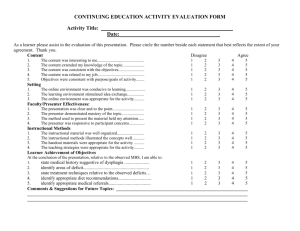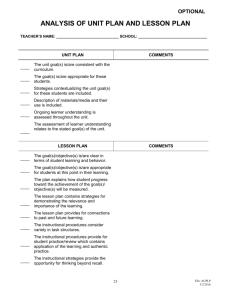
Kimberly Nix Berens, Ph.D., BCBA-D
Founding Director
The Fit Learning Method culminates from over 10 years of work with over a
thousand leaners. We have a vast understanding of how to produce profound
learning gains with every kind of student, which results in our continually achieving
the “impossible” with every learner who walks through our doors. There are many
characteristics of our approach that contribute to its effectiveness and distinguish it
dramatically from more traditional approaches.
Our Roots
Our method has its basis in learning science or behavior analysis, which
provides the guiding framework for everything we do. Learning science adheres to
“pragmatism” as its philosophical system – where effective action serves as the
rubric by which we judge our work as scientists and clinicians. In other words, we
evaluate our work in terms of its effectiveness at producing a desired result or
outcome. Conversely, in traditional education, “constructivism” is the guiding
theoretical framework; whereby, descriptions of what practices should be are
constructed and work is evaluated in terms of how closely educational practices
match the constructed descriptions of what these practices should be. In other
words, educational practices are evaluated in terms of whether what is happening in
classrooms matches what theorists say should be happening. Unfortunately, there
is little connection between practice and evaluation of outcomes in traditional
education.
The scientific principles of learning serve as the guiding system for our work.
Humans have evolved as a species to be sensitive to specific features of our
environment. Although biology clearly plays a role, over 70 years of research
indicates that the environment assumes a much greater role in learning. These
critical features of the environment have been systematically studied and they are
now scientifically validated principles of learning. It is these principles that have
guided the development and refinement of our method.
The Instructional Environment as Primary
We view a learner’s current and past instructional environments as primarily
responsible for learning gains. Instructional environments encompass a vast array
of features such as 1) how motivational systems are designed, 2) how learning
materials are designed and presented, 3) how responses by the learner are
prompted, secured, and strengthened 4) how feedback is provided, 5) how learning
is measured and evaluated, 6) how instruction is modified based on this evaluation,
and 7) how skill mastery is determined and produced. These are a few of the critical
features of instructional environments that impact the learning gains made by a
student. When students fail, struggle, stagnate, or require any kind of acceleration,
Kimberly Berens, Ph.D., BCBA-D
we turn to an analysis and modification of the critical features of that student’s
instructional environment.
Conversely, traditional education holds the student’s role in his or her own
learning as primary. From the traditional perspective, when a student struggles or
stagnates, it has to do with inherent characteristics of that student rather than due
to a faulty instructional environment. Struggling students are tested, labeled, placed
in special classes, and generally classified as having something wrong with them. As
a result, teaching practices and instructional environments remain unexamined,
ineffective practices become institutionalized, and special education placements and
learning disability diagnoses increase. Similarly, average or gifted students often
stagnate when instructional practices are not designed to maximize learning gains
with each learner as an individual. As a result, traditional educational environments
produce mediocre students, rather than producing highly trained, expert thinkers
capable of impacting our world in profound ways.
When learning problems or mediocrity are seen as existing inside the
student, it limits access to effective action. We have been profoundly effective with
every student due to our adherence to an examination of instructional
environments rather than viewing struggling or mediocre students as having some
inherent flaw. Yes, some students have a predisposition to struggling more
significantly in particular areas than others; however, faulty instructional
environments profoundly exacerbate such predispositions. The key to producing
profound learning gains with every single student lies in an analysis of that learner’s
history with respect to their current instructional environment.
Component Skill Building
The push in education today is content over competency. In other words, the
theory is that by exposing students to more and more information at younger and
younger ages they will eventually acquire enough knowledge to be successful.
Constructivist theories posit that educators simply must provide opportunities for
students to discover knowledge. Teachers are also trained that directly teaching
things somehow minimizes a student’s educational experience and suppresses
creativity or individuality. However, there is little scientific evidence to support
these current educational theories. Conversely, scientific evidence in combination
with 10 years of outcome data obtained with our own learners indicates that longterm academic success depends upon the achievement of competency in core skill
areas. Rather than exposing students to large amounts of content, competencybased educational practices, like those used at Fit Learning, entail building essential
skills to proficiency and following a logical, linear progression through a skill
sequence where larger, more advanced skills are not expected until the core,
component skills are sufficiently in place. For example, we would not expect a
learner to be able to effectively solve a complex math word problem before
achieving mastery of core numeration and basic computation skills. However,
students today are expected to perform these kinds of complicated skills with little
time spent training and mastering the components.
Copyright © 2014 by Fit Learning. All Rights Reserved.
www.fitlearners.com
Kimberly Berens, Ph.D., BCBA-D
Fluency as a True Measure of Mastery
Grading serves as the primary means of progress monitoring in schools.
However, grades also tend to be a fairly insensitive, subjective measure of student
performance. In the early years, teachers tend to grade based on effort, enthusiasm,
or possibly general cuteness of the kid. These kinds of subjective grading practices
tend to shift dramatically by 3rd or 4th grade, where students actually receive grades
based upon competency. Unfortunately, instructional practices do not tend to shift
with increasing strenuousness of grading practices. In other words, more starts
being expected of students but instructional practices do not ensure that all
students can meet those increased expectations. Similarly, most students are
evaluated by infrequent test grades. A teacher covers a unit of material for a week
or two and then students are tested on that material. The class moves on to a new
unit of material following the test regardless of how each student performed on the
test. None of these practices are predictive in nature. In other words, an A on a test
fails to predict if that student will remember the material in a week, a month, or
several years down the road. Also, an A fails to predict whether or not that student
will be able to use that material to learn something more difficult. Grades actually
predict nothing about future performance.
Conversely, we adhere to the notion that students should truly master basic
skills. By mastery, we mean that a student’s competency on a particular skill should
reliably predict that he/she remembers the skill over time in the absence of ongoing practice, can perform the skill under distracting conditions over long periods
of time without showing degradation in performance, and can effectively use that
skill for the learning of something more complex. Our science has determined that
fluency – or a measure of accuracy plus pace – is the most appropriate measure of
skill mastery and reliably predicts the desired outcomes described above. Fluency
serves as the goal for everything we train at Fit Learning. We have tested and
evaluated hundreds of students on thousands of skills and have established fluency
“aims” for every skill we train. These aims have been established by systematically
evaluating the levels of speed and accuracy on a skill that reliably produce the
desired outcomes described.
Cognitive Fitness
When students achieve fluency across a broad array of core skill areas for a
particular subject, they experience an actual transformation as a learner. A fluent
foundation produces learners who have cognitive fitness – or the ability to learn and
perform as an expert in any academic setting on any type of task. Students who are
cognitively fit tend to be agile, flexible, focused, perseverant, confident, determined,
and able to think critically. Fluency is synonymous with being an expert and with
the type of training that Fit Learning provides, students become experts in the core
skill areas of reading, math, thinking, and writing. As such, they can effortlessly
complete classroom and homework assignments and engage with material in such a
way that they actually begin teaching themselves new things. It is these kinds of
students who will go on to impact our world in profound ways. It is our
Copyright © 2014 by Fit Learning. All Rights Reserved.
www.fitlearners.com
Kimberly Berens, Ph.D., BCBA-D
commitment that we provide this type of training such that every student who
walks through our doors develops the kinds of skills and expertise that will allow
them to do great things and make a difference in their communities and beyond.
Copyright © 2014 by Fit Learning. All Rights Reserved.
www.fitlearners.com






